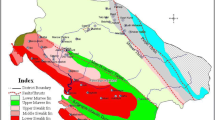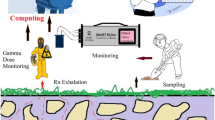Abstract
Radon and its progeny are major contributors in the radiation dose received by general population of the world. Keeping this in mind, the environmental monitoring of radon–thoron and their progeny in dwellings of district Rupnagar, Punjab, India has been carried out. Both radon–thoron twin dosimeter cups and the newly developed pin-hole dosimeters cups by BARC, India were used for the study. The study reveals good agreement between the values measured by the two types of dosimeters. Radon exhalation rate from soil samples of these dwellings/areas have been carried out using “Canister Technique.” The radon exhalation rates of some soil samples of these dwellings/areas were also measured by an active technique using a continuous radon monitor. Both the active and passive techniques show the exhalation rate values to be lower than the worldwide average. The study of the exhalation rate of the soil samples of Nangal and Anandpur Sahib of the district Rupnagar and the sand samples available from the study area has also been carried out for the possible use as construction material. The in situ gamma dose varied from 0.13 to 0.33 µSv/h.




Similar content being viewed by others
References
Abu-Jarad F, Fremlin JH, Bull R (1980) A study of radon emitted from building materials using plastic α-track detectors. Phys Med Biol 25(4):683–694
Akerblom G, Andersson P, Clavensjo B (1984) Soil gas radon: a source for indoor radon daughters. Radiat Prot Dosim 7(1–4):49–54
Al-Jarallah M (2001) Radon exhalation from granites used in Saudi Arabia. J Environ Rad 53(1):91–98
Arvela H, Winqvist K (1989) A model for indoor radon variations. Environ Intern 15(1–6):239–249
Auvinen A, Mäkeläinen I, Hakama M, Castrén O, Pukkala E, Reisbacka H, Rytömaa T (1996) Indoor radon exposure and risk of lung cancer: a nested case—control study in Finland. JNCI J Natl Cancer Inst 88(14):966–972
Badhan K, Mehra R, Sonkawade RG (2010) Measurement of radon concentration in ground water using RAD7 and assessment of average annual dose in the environs of NITJ, Punjab, India. Indian J Pure Appl Phys 48:508–511
Badhan K, Mehra R, Sonkawade RG (2012) Studying the variation of indoor radon levels in different dwellings in Hoshiarpur District of Punjab India. Indoor Built Environ 21:601–606
Barnet I (2012) Indoor radon probability calculated from the Czech soil gas radon data in a grid net for the European Geogenic Radon Map construction: test of feasibility. Environ Earth Sci 66:1149–1153. doi:10.1007/s12665-011-1322-3
Beir, VI, Report of the Committee on the Biological effects of Ionizing Radiation (1999) Health Effects of Exposure to Radon, National Research Council. National Academy Press, Washington, DC
Blot WJ, Xu ZY, Boice JD Jr, Zhao DZ, Stone BJ, Sun J, Jing LB, Fraumeni JF Jr (1990) Indoor radon and lung cancer in China. JNCI J Natl Cancer Inst 82(12):1025–1030
Chauhan RP, Chakarvarti SK (2002) Radon Exhalation rates from soils and stones as building materials. Indian J Pure Appl Phys 40:670–673
Cothern CR, Lappenbusch WL (1986) Drinking-water contribution to natural background radiation. Health Phys 50:33–47
Doi M, Kobayashi S, Fujimoto K (1992) A passive measurement technique for characterization of high-risk houses in Japan due to enhanced levels of indoor radon and thoron concentrations. Radiat Prot Dosim 45(1–4):425–430
Eappen KP, Mayya YS (2004) Calibration factors for LR-115 (type II) based radon thoron discriminating dosimeter. Radiat Meas 38:5–17
Eaton RS, Scott AG (1984) Understanding radon transport into houses. Radiat Prot Dosim 7(1–4):251–253
Ferlay J, Shin HR, Bray F, Forman D, Mathers C, Parkin DM (2010) GLOBOCAN 2008. Cancer Incidence and Mortality Worldwide: IARC Cancer Base No. 10 [Internet]. Lyon, France: International Agency for Research on Cancer http://globocan.iarc.fr. Accessed Aug 2011
ICRP (1993) International Commission on Radiological Protection. Pergamon Press, Oxford, ICRP Publication No. 65
International Commission on Radiological Protection (2009) Statement on radon. ICRP Ref 00/902/09. http://www.icrp.org/consultation_page.asp
Kainan Sun, Qiuju Guo, Weihai Zhuo (2004) Feasibility for Mapping Radon Exhalation Rate from Soil in China. J Nuc Sc Tech 41(1):86–90
Kant K, Chakarvarti SK (2004) Radiological impact of airborne radon and its progeny in dwellings. Indian J Pure Appl Phys 42:157–161
Khan MS, Azam A (2013) Measurements of indoor radon, thoron, and their progeny using twin cup dosimeters in rural areas of Northern India. Environ Earth Sci. doi:10.1007/s12665-013-2538-1
Khan AJ, Rajendra Prasad, Tyagi RK (1992) Measurement of radon exhalation rate from some building materials. Nucl Tracks Radiat Meas 20(4):609–610
Khan MS, Srivastava DS, Azam A (2012) Study of radium content and radon exhalation rates in soil samples of northern India. Environ Earth Sci. doi:10.1007/s12665-012-1581-7
Kumar R, Sengupta D, Prasad R (2003) Natural radioactivity and radon exhalation studies of rock samples from Surda Copper deposits in Singhbhum shear zone. Radiat Meas 36:551–553
Mahur AK, Gupta M, Varshney R, Sonkawade RG, Verma KD, Prasad R (2013) Radon exhalation and gamma radioactivity levels in soil and radiation hazard assessment in the surrounding area of National Thermal Power Corporation, Dadri (UP). India. Radiat Meas 50:130–135
Mehra R, Bala P (2013) Assessment of radiation hazards due to the concentration of natural radionuclides in the environment. Environ Earth Sci. doi:10.1007/s12665-013-2493-x
Mehra R, Singh S, Singh K (2006) A study of uranium, radium, radon exhalation rate and indoor radon in the environs of some areas of the Malwa region, Punjab. Indoor Built Environ 15(5):499–505
Petropoulos NP, Anagnostakis MJ, Simopoulos SE (2001) Building materials radon exhalation rate: ERRICCA intercomparison exercise results. Sci Total Environ 272:109–118
Petropoulos NP, Anagnostakis MJ, Simopoulos SE (2002) Photon attenuation, natural radioactivity content and radon exhalation rate of building materials. J Environ Radioact 61:257–269
Rani VR (2007) Ground water information booklet S.A.S Nagar District Punjab: Central Ground Water Board, Ministry of Water Resources, Government of India, Publication 2007, pp 1–26
Sahoo BK, Nathwani D, Eappen KP, Ramachandran TV, Gaware JJ, Mayya YS (2007) Estimation of radon emanation factor in Indian building materials. Radiat Meas 42:1422–1425
Sahoo BK, Sapra BK, Kanse SD, Gaware JJ, Mayya YS (2013) A new pin-hole discriminated 222Rn/220Rn passive measurement device with single entry face. Radiat Meas 58:52
Sannappa J, Chandrashekera MS, Sathish LA, Paramesh L, Venkataramaiah P (2003) Study of background radiation dose in Mysore city, Karnataka State, India. Radiat Meas 37:55–65
Sharaf M, Mansy M, El Sayed A, Abbas E (1999) Natural radioactivity and radon exhalation rates in building materials used in Egypt. Appl Radiat Isot 13(1–6):491–495
Sharma SP (2012) The Tribune: Survey to collect data on cancer patients. http://www.tribuneindia.com/2012/20120925/punjab.htm#8. Accessed 27 Sep 2012
Singh AK, Khan AJ, Prasad R (1997a) Distribution of 222Rn levels in Indian dwellings. Radiat Prot Dosim 74(3):189–192
Singh AK, Jojo PJ, Khan AJ, Prasad R, Ramachandran TV (1997b) Calibration of track detector and measurement of radon exhalation artes from soil sample. Radiat Prot Environ 20:129
Singh S, Malhotra R, Kumar J, Singh L (2001) Indoor radon measurements in dwellings of Kulu area, Himachal Pradesh, using solid state nuclear track detectors. Radiat Meas 34(1–6):505–508
Singh S, Kumar M, Mahajan RK (2005a) The study of indoor radon in dwellings of Bathinda district, Punjab, India and its correlation with uranium and radon exhalation rate in soil. Radiat Meas 39:535–542
Singh S, Mehra R, Singh K (2005b) Seasonal variation of indoor radon in dwellings of Malwa region, Punjab. Atm Environ 39:7761–7767
Singh H, Singh J, Singh S, Bajwa BS (2008a) Regional variations pattern of indoor radon levels in some areas of Punjab and Haryana. Radiat Prot Dosim 130(2):257–263
Singh H, Singh J, Singh S, Bajwa BS (2008b) Radon exhalation rate and uranium estimation study of some soil and rock samples from Tusham ring complex, India using SSNTD technique. Radiat Meas 43:S459–S462
Sroor A, El-Bahi SM, Ahmed F, Abdel-Haleem AS (2001) Natural radioactivity and radon exhalation rate of soil in southern Egypt. Appl Radiat Isot 55:873–879
Stoulos S, Manolopoulou M, Papastefanou C (2003) Assessment of natural radiation exposure and radon exhalation from building materials in Greece. J Environ Radioact 69:225–240
Thomas DC, McNeill KG, Dougherty C (1985) Estimates of lifetime lung cancer risks resulting from Rn progeny exposure. Health Phys 45(5):825–846
Toth E, Deak F, Gyurkosza CS, Kasztovsky ZS, Kuczi R, Mark G, Nagy B, Oberstedt S, Sajo-Bohus L, Sukosd CS, Toth G, Vajda N (1997) Radon variation in a Hungarian village. Environ Geol 31:123–127
Tribune News Service (TNS) (2013) The Tribune: 18 die of cancer in Punjab everyday. http://www.tribuneindia.com/2013/20130129/main3.htm. Accessed 30 Jan 2013
United States Environmental Protection Agency (2014) Health Risks, http://www.epa.gov/radon/healthrisks.html. Accessed 22 Mar 2014
UNSCEAR (1992) (United Nations Scientific Committee on the Effects of Atomic Radiation) Exposures from Natural Sources of Radiation, A_Ac, 82_R. p 511
UNSCEAR (2000) Sources and Effects of Ionizing Radiation. Report to the General Assembly with Scientific Annexes, United Nations Scientific Committee on the Effects of Atomic Radiation, New York
Virk HS, Sharma N (2000) Indoor radon/thoron survey report from Hamirpur and Una districts, Himachal Pradesh, India. Appl Radiat Isotopes 52:137–141
Author information
Authors and Affiliations
Corresponding author
Rights and permissions
About this article
Cite this article
Mehta, V., Chauhan, R.P. & Mudahar, G.S. Monitoring of radon, thoron, their progeny concentrations in dwellings, and radon exhalation rates of soil/sand of Rupnagar district, Punjab, India. Environ Earth Sci 74, 4145–4155 (2015). https://doi.org/10.1007/s12665-015-4492-6
Received:
Accepted:
Published:
Issue Date:
DOI: https://doi.org/10.1007/s12665-015-4492-6




